Thursday 8 September 2016
White: A. Gillard (113) - Black: K. Nevols (134)
And so we begin a new season and a new club championship, and a difficult first game. As I mentioned previously, my opponent is stronger than the grade suggests and I knew a tough fight was ahead.
1. d4
In our last game, 1. e4 was played. As luck would have it, I had recently been looking at the Kings Indian Defence, a opening I decided to abandon after a bad defeat last season but, as yet, have yet to find a decent alternative.
Many years ago, the Benko Gambit was a regular part of my repertoire. A revival might be an idea for another day. But, for now, the old KID gets another outing.
1. ... Nf6
2. c4 g6
3. Nc3 Bg7
4. e4 d6
5. f4
Unfortunately my current examination of the Kings Indian Defence had not yet got to the bit where White unleashes the Four Pawns Attack, so already I was on my own against a possibly prepared offensive.
The idea behind the Four Pawns Attack is quite simple - to ground Black down with a pawn offensive through the centre, and use the extra space gained. Black, on the other hand, will hope to undermine the centre with pawn breaks.
5. .... O-O
The main line, although 5 .. c5 is sometimes seen, either transposing to the main line with 6. d5 O-O or meeting 6. dxc5 with 6. ... Qa5!? and getting the pawn back with 7. Qd2 Qxc5 or, if White feels brave, 7. exd6 Nxe4!
6. e5
Unusual. The main line is 6. Nf3 c5 7. d5 and Black can think about 7. .. e6 or 7 ... Bg4. In this game, White delays castling to build up the offensive.
6. .... dxe5?!
Already a mistake. Black breaks up his own pawn centre and does nothing to stop White. That pawn on f4 was doing a good job at blocking White's queen bishop.
7. fxe5 Nfd7
I gave some thought to Ne8 but, despite blocking the bishop, moving to d7 looked more natural to support the c5 counter attack. However White himself could now play 8. c5 and Black begins to look uncomfortable already (8. ... Nf6 9. Be3 - 8. .. b6 9. Qf3!). I had also considered whether White could sacrifice a pawn with 8. e6 but saw no danger there.
8. Bg5
Instead White goes for a fascinating plan by using piece play to attack the e7 point.
8. .... c5
The logical step after the last move. Attempting to dissolve White's centre in Indian opening tradition.
9. Nf3
White continues development. Now I gave a lot of thought to two moves. I was strongly tempted to play 9 .. Nc6 developing and continuing the pressure in the centre. My initial concerns over 9 .. cxd4 revolved around 10. Qxd4 until I saw that 10. ... Nxe5 would win a pawn. Then I moved on to my other concern about 9. .. cxd4 - which was about bringing both his knights into the centre and possibly ending up on b5 and d5 - which looked rather scary.
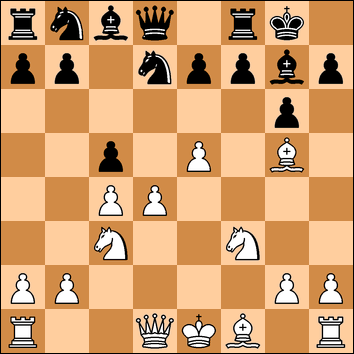
After devising a plan to deal with this, I decided to bag the pawn.
9. ... cxd4
10. Nd5 Nc6
11. Nxd4
The computer now recommends 11. .. Re8. It thinks I was too worried about the e7 point and says that 12. Nxc6 bxc6 13. Nxe7 (or 13. Bxe7) is nothing to worry about. 13. .. Rxe7 14. Bxe7 Qxe7. White has a rook and a pawn for a knight and a bishop - but the white king is still in the centre and the pawn on e5 will soon be on its way.
11. ... Ndxe5
But I'll take the pawn anyway.
12. Nb5 f6
I had to do something to push back White's pieces but was not happy with this move which blocks in the bishop. Indeed, this bishop never again sees the light of day. 12. ... h6 13. Be3 Bg4 (13. Bh4 g5) and then e6 would have been a much better plan.
13. Be3
Now looking at the a7 square and also the prospect of squashing the rook. I had to get some space.
13. ... Bf5
A good square for the bishop but adding further to the restriction imposed to the other bishop.
The line I had looked at was now 14. Ndc7 Rc8 15. Qxd8 Rfxd8 16. Nxa7 Nxa7 17. Bxa7 and then if 17. ... Rxc7 18. Bb6 and after 18. .. Rcd7 19. Bxd8 Rxd8 Black has two pieces for the rook. The computer says this is an easy win for Black but I was not so sure.
I then considered 14. Ndc7 Nb4! and this is indeed a strong move which after 15. Be2 gives Black the choice of Nc2+ or Nbd3+. As I was further examining these lines, and went off to buy another Diet Coke, White played something else.
14. Be2
Preparing to castle and perhaps thinking of g4 one day.
Now another big think as I took a close look at 14. .. e6. The move 15. Ndc7 leads to the same sequence as above although White might, as he did later, opt for 15. Ng4.
However, this is a better move to the one I played. I was concerned about the bishop coming to c5, and also to the diagonal towards a7 and so decided to block both these possibilities.
14. .... b6
The time control was 35 moves in 75 minutes and then 15 minutes for all the others. By now, White has 40 minutes left for 21 moves and I had 36 minutes left.
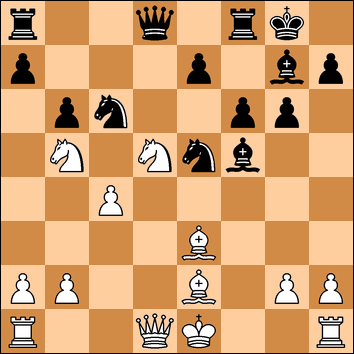
I now saw 15. c5 and thought it won straight away. 15. .. bxc5 16. Bxc5 and White has astonishing pressure in the centre as well as, long term, a 2 v1 advantage on the queenside.
But Black has the crafty 16. .. Nd3+! and after 17. Bxd3 Qxd5 all is in order. (18. Nc7?? Qe5+).
15. O-O Rc8
Finally putting an end to Nc7 worries and glancing at that pawn on c4.
16. Qe1!
A neat sidestep with the ideas of putting a rook on d1 (which I saw) and moving the queen into an attack (which I did not).
16. ... e6
17. Nf4 Qe7
Now I was feeling happier. I am still a pawn up and everything seems in order. If only I could exchange a few pieces.
18. Rd1 Rfd8
19. Qg3
This surprised me, as I had expected g4 at some point. I glanced at moves like a sacrifice on g6, or h4-h5 and thought I could hold.
19. .. Nb4
20. Nd4
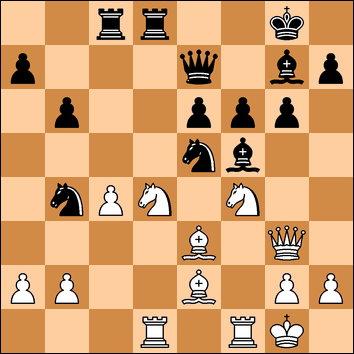
I was not afraid of Nxf5 exf5 which I thought looked safe, and decided to bag another pawn.
20. .... Nxc4
White now tries a sequence of moves with the sacrifice on g6 in mind. I had given this no further thought.
21. Nxf5 exf5
22. Rxd8 Qxd8
23. Bxc4 Rxc4
So I am now two pawns up and seemingly cruising.
24. h3
I had assumed this was to give his king some air. Instead it had been intended to prevent my playing Rg4 after Nxg6 - something else I did not see.
24. ... Rc2
White now plays his card.
25. Nxg6?! hxg6
26. Qxg6
I now come up with the astonishingly bad plan of seeking to defend with the rook and attack with the queen instead of the other way round.
26. ... Re2
27. Bh6
After the game I tried out various things from this position but White has an astonishing amount of play.
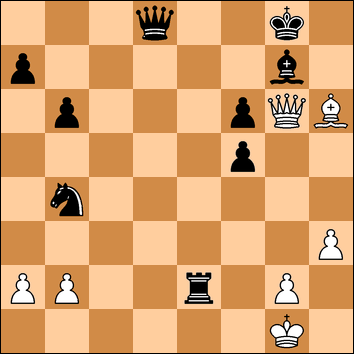
One line is 27. ... Qe7 28. Rxf5 Re1+ (Kh8?? 29. Bxg7 Qxg7 30. Qh5+) 29. Kh2 Qc7+ 30. Bf4
or my favourite was 27. .. Qc7 (to stop Rxf5) 28. Bf4 Qc5+ 29. Kh1 Nd5 30. Rc1 Qxc1!? 31. Bxc1 Re1+ 32. Kh2 Rxc1 where Black has three pieces for the queen - a very curious ending.
27. ... Qd4+
28. Kh1 Re7???
28. ... Qd7 simply keeps the advantage. It is premature to say it is definitely winning but at least it keeps those chances.
Although I was unhappy at having, what I considered, to have thrown away a win - hence my blame of 27. .. Qd4+ - in actual fact, the subsequent rook move, I was astonished afterwards to discover, had thrown away a draw too.
29. Bxg7 Rxg7
30. Qe8+ Kh7
31. Qh5+ Kg8
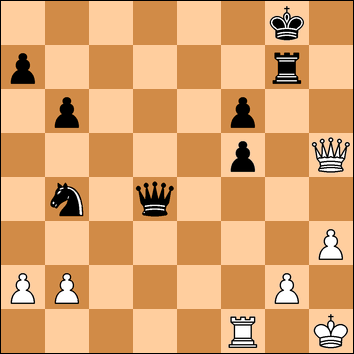
32. Qe8+
and offers a draw (???) which was agreed.
32. Re1! - intending a journey to the e8 square - wins. Black plays 32. .. Qd6 33. Re8+ Qf8 34. Rxf8+ Kxf8 35. Qxf5 and White has a queen and a pawn for a rook and a knight with no chances at all for a fortress.
As expected a tough battle for the first game - and my initial sense of anger and disappointment is replaced by a feeling of relief.
No comments:
Post a Comment